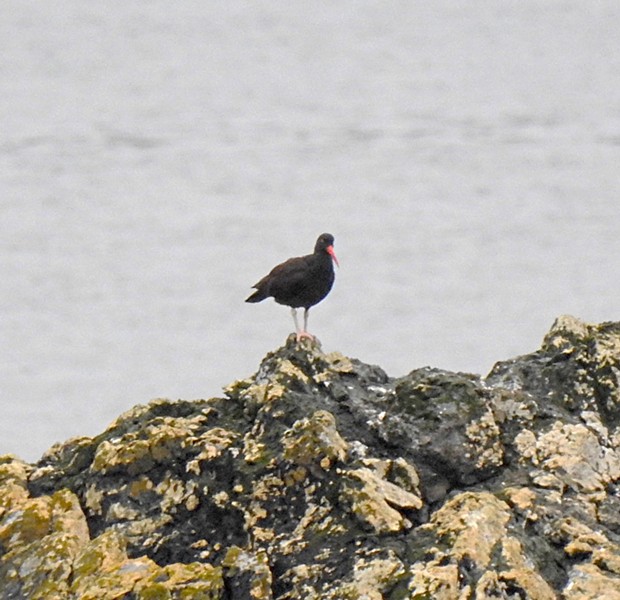Colorful" and "glamorous" aren't words that usually spring to mind when it comes to shorebirds, the diverse group of generally drab birds that includes sandpipers, plovers and related species. Their beauty tends to lie in sheer numbers: When flocks of thousands wheel in unison over Humboldt Bay and the light flashes off their pale bellies, it's a dazzling sight, especially if there's a peregrine falcon in pursuit.
But not all our local shorebirds are dressed in 50 shades of gray — there are some odd ducks in this family tree that are absolutely fabulous (though not actual ducks). Keep an eye out for some of these eye-catching avians around the bay, coastal shores and marshy lowlands throughout the county.
American avocet. Statuesque and elegant, American avocets appear ready to walk the runway. Their bold winter pattern of black and white becomes even more striking when their heads turn a warm shade of cinnamon in the spring. Avocets have bills that are unusually long, thin and upcurved, and small flocks of a few birds to 50 or more strut on long skinny legs through the shallows of the bay, sweeping those bills back and forth to stir up good things to eat. Between their offbeat feeding technique and stylish looks, avocets are easy to learn to identify and unforgettable once you do. A great place to see one (or more) is in the bay off I Street at the Arcata Marsh.
Killdeer. Even nonbirders are likely to be familiar with this boldly striped bird with the strident call from which it gets its name. It sports a brown body and cap with a contrasting white breast and two dark brown necklaces. If you get close enough, you might be able to spot its cool red eye-ring and orange rump. Killdeers belong to the plover family, stout shorebirds with short thick bills, and can often be found in pastures and plowed fields around the Arcata and McKinleyville Bottoms. They've also adapted to suburban life and have been known to lay their eggs in ballfields and gravel parking areas, famously feigning a broken wing to lure intruders away from the nest.
Semipalmated plover. This is the killdeer's "mini-me" cousin, similar in appearance but half its size and with just a single dark necklace. It's common on mudflats feeding with small sandpipers.
Black oystercatcher. These beautiful crow-sized shorebirds are found on rocky headlands along the coast, sometimes feeding in tidepools. They're almost solid black with a yellow eye encircled in red and a bright red bill that they use like a blade to crack open shellfish. You may have heard their loud repeated "wheep" calls from the pier at Trinidad Harbor, which is a good place to see one.
Wilson's snipe. A "snipe hunt" is a practical joke wherein some unwitting victim is sent on a fool's errand, leading many to believe a snipe is some sort of imaginary creature. On the contrary, a snipe is a fun, funky shorebird — chubby and long-billed, with a striped head, outrageous mottled plumage of brown, rust and tan,and pale "suspenders" down its back. But my favorite feature is their googly eyes, set high on the forehead — sometimes those eyes are the first thing you see peering out of the grass. Snipes like wet pastures and other boggy areas. When they're startled, they burst out of cover and fly low over the ground; the air rushing through their outer tail feathers makes a haunting sound called "winnowing."
Phalaropes. Quirky, lovely shorebirds, phalaropes win the prize for having the coolest name (from the Greek meaning "weird sandpipers with lobed toes") and also the one that's mispronounced most often (accent on the first syllable). They're unique in that they're more often found on the water, not wading through it — they use those lobed toes to swim, spinning in tight circles to create whirlpools that draw up tasty invertebrates. And here's a fun phalarope fact: The males of the family are duller than the females, incubate the eggs and care for the chicks while their flashy egg-mamas hit the sand bars in search of a brand new mate. You go, girls! All three North American species of phalarope — Wilson's, red-necked and red — can be seen here in Humboldt at different times of the year, usually in the fall and winter when their glorious breeding plumage has transitioned to more muted hues, but they're still a treat to see. Look for the red phalarope on the beaches or in the ocean right about now, while the other two can be found spinning away on marshes and sloughs in the spring and fall.
So be on the lookout for some of these unique characters as you wander around Humboldt's bay and marsh trails, or drive through scenic farmland. You just might see some stunners that will change your mind about shorebirds.
Sarah Hobart (she/her) is a freelance writer based in Humboldt County.





Comments
Showing 1-1 of 1